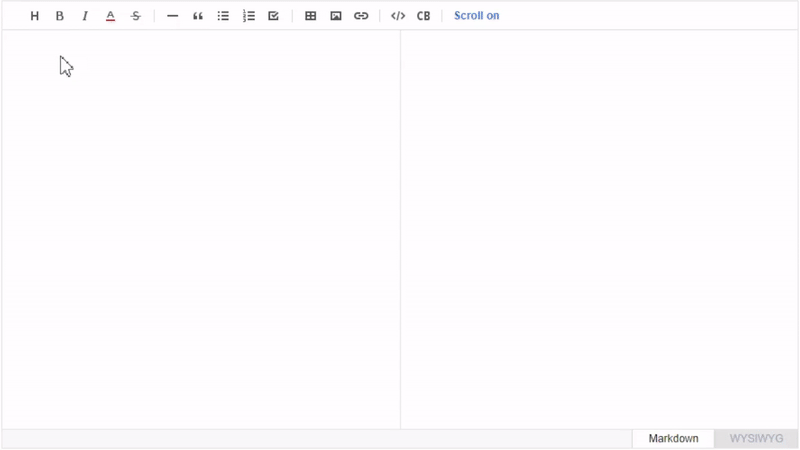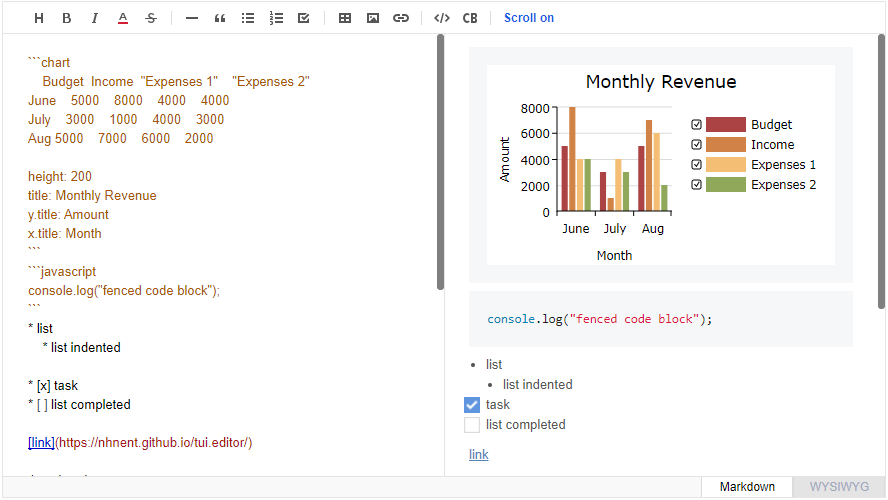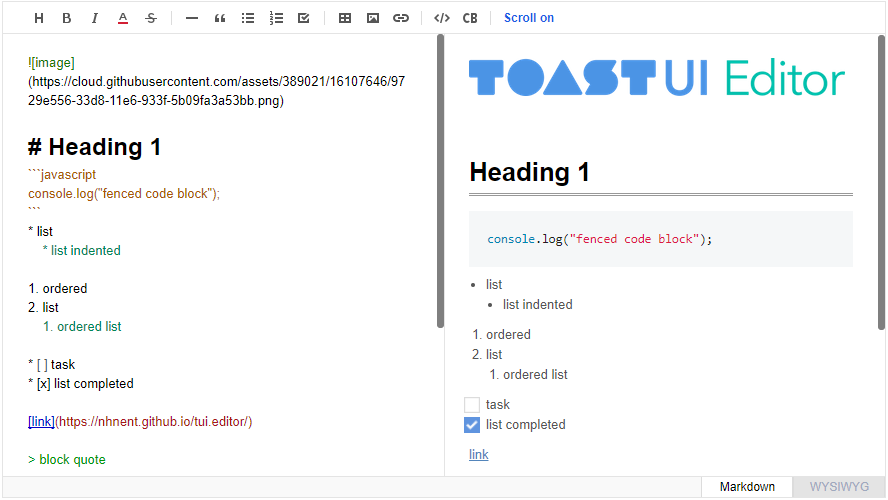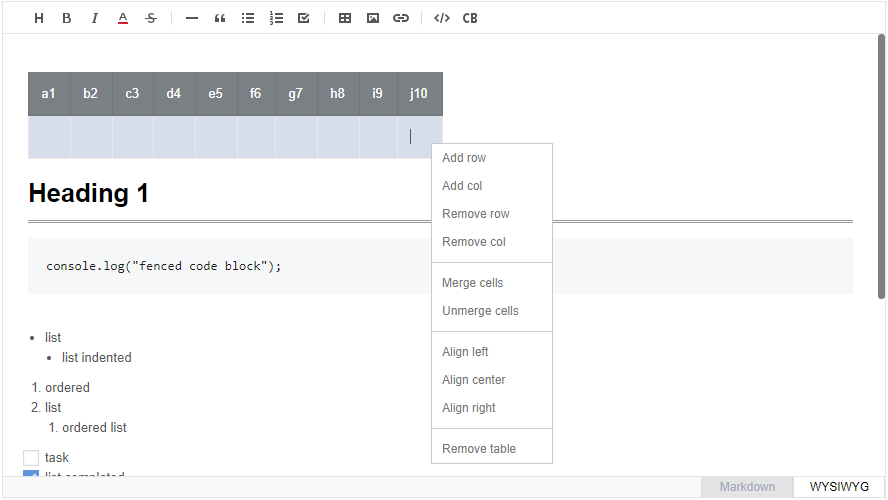Gathering detailed insights and metrics for tui-editor
Gathering detailed insights and metrics for tui-editor
Gathering detailed insights and metrics for tui-editor
Gathering detailed insights and metrics for tui-editor
tui-image-editor
TOAST UI ImageEditor
@abp/tui-editor
ABP Framework is a complete open-source infrastructure to create modern web applications by following the best practices and conventions of software development. This package is a part of the [ABP Framework](https://abp.io) and contains client-side files.
@cocreate/tui-image-editor
A simple tui-image-editor component in vanilla javascript. Easily configured using HTML5 attributes and/or JavaScript API.
grapesjs-tui-image-editor
GrapesJS TOAST UI Image Editor
🍞📝 Markdown WYSIWYG Editor. GFM Standard + Chart & UML Extensible.
npm install tui-editorTypescript
Module System
Node Version
NPM Version
TypeScript (85.81%)
CSS (4.99%)
JavaScript (4.96%)
HTML (4.13%)
Vue (0.11%)
Total Downloads
0
Last Day
0
Last Week
0
Last Month
0
Last Year
0
MIT License
17,601 Stars
361 Commits
1,814 Forks
227 Watchers
56 Branches
114 Contributors
Updated on Jul 15, 2025
Latest Version
1.4.10
Package Id
tui-editor@1.4.10
Size
4.79 MB
NPM Version
6.11.3
Node Version
10.17.0
Published on
Dec 12, 2019
Cumulative downloads
Total Downloads
Last Day
0%
NaN
Compared to previous day
Last Week
0%
NaN
Compared to previous week
Last Month
0%
NaN
Compared to previous month
Last Year
0%
NaN
Compared to previous year
14
43

GFM Markdown WYSIWYG Editor - Productive and Extensible

TOAST UI Editor applies Google Analytics (GA) to collect statistics on the use of open source, in order to identify how widely TOAST UI Editor is used throughout the world. It also serves as important index to determine the future course of projects. location.hostname (e.g. > “ui.toast.com") is to be collected and the sole purpose is nothing but to measure statistics on the usage. To disable GA, use the following usageStatistics options when creating editor.
1const options = { 2 // ... 3 usageStatistics: false 4} 5 6const instance = new Editor(options);
Or, include tui-code-snippet(v1.5.0 or later) and then immediately write the options as follows:
1tui.usageStatistics = false;
 Standard and Extensible
Standard and Extensible
Today CommonMark is the de-facto Markdown standard. GFM (GitHub Flavored Markdown) is another popular specification based on CommonMark - maintained by GitHub, which is the Markdown mostly used. TOAST UI Editor follows both CommonMark and GFM specifications. Write documents with ease using productive tools provided by TOAST UI Editor and you can easily open the produced document wherever the specifications are supported.
CommonMark and GFM are great, but we often need more abstraction. The TOAST UI Editor comes with powerful Extensions in compliance with the Markdown syntax. You also get the flexibility to develop your own extensions using simple APIs.
Here are some of the extensions you can start with:
To learn more about Extensions check the Using Extension.
TOAST UI Editor provides Markdown mode and WYSIWYG mode.
Depending on the type of use you want like production of Markdown or maybe to just edit the Markdown. The TOAST UI Editor can be helpful for both the usage. It offers Markdown mode and WYSIWYG mode, which can be switched any point in time.


TOAST UI products can be used by using the package manager or downloading the source directly. However, we highly recommend using the package manager.
TOAST UI products are registered in two package managers, npm and bower. You can conveniently install it using the commands provided by the package manager. When using npm, be sure to use it in the environment Node.js is installed.
1$ npm install --save tui-editor # Latest version 2$ npm install --save tui-editor@<version> # Specific version
TOAST UI products are available over the CDN powered by TOAST Cloud.
You can use the CDN as below.
1<!-- Styles --> 2<link rel="stylesheet" href="https://uicdn.toast.com/tui-editor/latest/tui-editor.css"></link> 3<link rel="stylesheet" href="https://uicdn.toast.com/tui-editor/latest/tui-editor-contents.css"></link> 4<link rel="stylesheet" href="https://cdnjs.cloudflare.com/ajax/libs/codemirror/5.48.4/codemirror.css"></link> 5<link rel="stylesheet" href="https://cdnjs.cloudflare.com/ajax/libs/highlight.js/9.12.0/styles/github.min.css"></link> 6<!-- Scripts --> 7<script src="https://uicdn.toast.com/tui-editor/latest/tui-editor-Editor-full.js"></script>
If you want to use a specific version, use the tag name instead of latest in the url's path.
The CDN directory has the following structure.
tui-editor/
├─ latest/
│ ├─ tui-editor-Editor.js
│ ├─ tui-editor-Editor.min.js
│ └─ ...
├─ v1.1.0/
│ ├─ ...
The code below shows an example of using ES6 in node environment. If you are using bower please see Getting Started with Bower.
Add the container element where TOAST UI Editor will be created.
1<div id="editorSection"></div>
TOAST UI Editor can be used by creating an instance with the constructor function. To get the constructor function, you should import the module using one of the following ways depending on your environment.
1const Editor = require('tui-editor'); /* CommonJS */
1import Editor from 'tui-editor'; /* ES6 */
Then import styles of TOAST UI Editor and dependencies.
1import 'tui-editor/dist/tui-editor.css'; // editor's ui 2import 'tui-editor/dist/tui-editor-contents.css'; // editor's content 3import 'codemirror/lib/codemirror.css'; // codemirror 4import 'highlight.js/styles/github.css'; // code block highlight
Finally you can create an instance with options and call various API after creating an instance.
1import 'codemirror/lib/codemirror.css'; 2import 'tui-editor/dist/tui-editor.css'; 3import 'tui-editor/dist/tui-editor-contents.css'; 4import 'highlight.js/styles/github.css'; 5 6import Editor from 'tui-editor'; 7 8const instance = new Editor({ 9 el: document.querySelector('#editorSection'), 10 initialEditType: 'markdown', 11 previewStyle: 'vertical', 12 height: '300px' 13}); 14 15instance.getHtml();
If you use jQuery plugin, you can use it as follows.
1$('#editorSection').tuiEditor({ 2 initialEditType: 'markdown', 3 previewStyle: 'vertical', 4 height: '300px' 5});
height: Height in string or auto ex) 300px | autoinitialValue: Initial value. Set Markdown stringinitialEditType: Initial type to show markdown | wysiwygpreviewType: Preview style of Markdown mode tab | verticalusageStatistics: Let us know the hostname. We want to learn from you how you are using the Editor. You are free to disable it. true | falseFind out more options here
TOAST UI Editor provides the Viewer in case you want to show Markdown content without loading the Editor. The Viewer is much lighter than the Editor.
1import 'tui-editor/dist/tui-editor-contents.css'; 2import 'highlight.js/styles/github.css'; 3 4import Viewer from 'tui-editor/dist/tui-editor-Viewer'; 5 6const instance = new Viewer({ 7 el: document.querySelector('#viewerSection'), 8 height: '500px', 9 initialValue: '# content to be rendered' 10}); 11 12instance.getHtml();
Be careful not to load both the Editor and the Viewer at the same time because the Editor already contains the Viewer function, you can initialize editor Editor.factory() and set the viewer option to value true in order to make the editor a viewer. You can also call getHtml() to render the HTML.
1import Editor from 'tui-editor'; 2 3const instance = Editor.factory({ 4 el: document.querySelector('#viewerSection'), 5 viewer: true, 6 height: '500px', 7 initialValue: '# content to be rendered' 8});
TOAST UI Editor follows CommonMark and GFM. So any Markdown renderer including markdown-it can handle the content made using TOAST UI Editor. You can also use any of these renderer in place of TOAST UI Editor Viewer.
 Chrome Chrome |  Internet Explorer Internet Explorer |  Edge Edge |  Safari Safari |  Firefox Firefox |
|---|---|---|---|---|
| Yes | 10+ | Yes | Yes | Yes |
All TOAST UI products are open source. A Pull Request (PR) can be made upon fixing an issue or developing additional features to be implemented.
To install, first fork the master branch to your own personal repository. Then, clone the forked repository to your local machine, and install the following node module. Prior to development, first, make sure that the modules are properly installed.
1$ git clone https://github.com/{your-personal-repo}/tui.editor.git 2$ cd tui.editor 3$ npm install 4$ npm run test
You can see your code is reflected as soon as you saving the codes by running a server. Don't miss adding test cases and then make green rights.
1$ npm run serve
1$ npm run test
Before creating a PR, test and check for any errors. If there are no errors, then commit and push.
For more information, please refer to the Contributing section.

No vulnerabilities found.
Reason
no dangerous workflow patterns detected
Reason
no binaries found in the repo
Reason
license file detected
Details
Reason
dependency not pinned by hash detected -- score normalized to 4
Details
Reason
Found 9/30 approved changesets -- score normalized to 3
Reason
0 commit(s) and 0 issue activity found in the last 90 days -- score normalized to 0
Reason
no effort to earn an OpenSSF best practices badge detected
Reason
detected GitHub workflow tokens with excessive permissions
Details
Reason
security policy file not detected
Details
Reason
project is not fuzzed
Details
Reason
SAST tool is not run on all commits -- score normalized to 0
Details
Reason
92 existing vulnerabilities detected
Details
Score
Last Scanned on 2025-07-07
The Open Source Security Foundation is a cross-industry collaboration to improve the security of open source software (OSS). The Scorecard provides security health metrics for open source projects.
Learn More